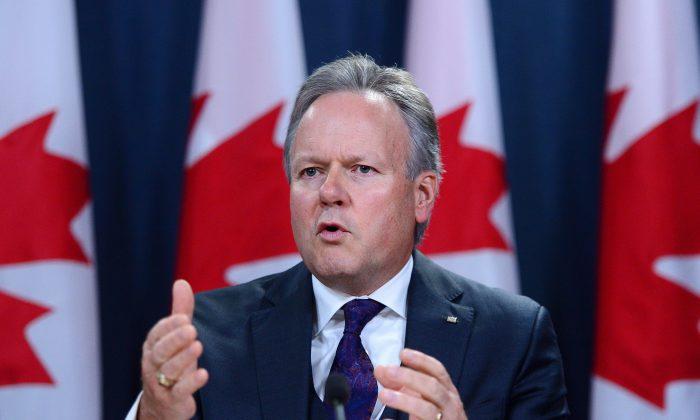With economic growth over the last four quarters averaging 3.7 percent, the central bank, not surprisingly, expects it to moderate in the second half of 2017. Exports are projected to be lower than what was forecast in July due to the rapid rise in the Canadian dollar. The loonie rose by more than 13 percent from early May to mid-September.
The BoC estimates that the economy is operating at close to full capacity. It adjusted its estimate of potential output—the economy’s “speed limit”—up 0.1 percent to 1.5 percent reflecting the improvement in business investment, which adds to productive capacity.
But one area of economic slack is the labor market, where long-term unemployment remains high and average hours worked and wage growth remain low.
Deep Dive on Inflation
The bank focuses on future inflation, as rate changes take at least 18 months to affect the economy. Inflation ticked higher to 1.6 percent in September—still noticeably below the 2 percent target, despite the economy being nearly at full capacity. The bank’s three measures of core inflation have also edged higher as the output gap has narrowed; however, they can also be affected by transitory factors like low food prices and Ontario’s electricity price rebates.The issues of globalization and advances in technology have been postulated as systemic factors depressing inflation globally, but the BoC feels they are, at best, minor factors depressing Canadian inflation.
“Inflation depends mainly on the degree of excess demand or excess supply in the economy,” Poloz said in his opening remarks at the bank’s press conference.
Regarding globalization, the BoC’s analysis did not detect any weakening effect on inflation resulting from cheap imports or Canada’s integration in global production chains.
And given Canada’s relatively low adoption of e-commerce, digitalization’s impact on inflation is estimated to be small. The BoC cites evidence that online and offline prices are similar. For now, the “Amazon effect” appears to be limited in Canada.
“The evidence today isn’t very compelling at all,” said Senior Deputy Governor Carolyn Wilkins about the effects from e-commerce that could be depressing Canadian inflation.
More broadly, Wilkins says it’s not clear that productivity has improved due to recent improvements in technology.
“The evidence in terms of productivity and digitalization is not strong in any country, that’s for sure,” Wilkins said. She said it could still be early days, but evidence in the data needs to be seen for structural changes to be warranted in inflation measurement.
The impact of technology on economic theory is a hot topic, as even the measurement of GDP comes into question, something that Steve Ambler, the David Dodge Chair in Monetary Policy at the C.D. Howe Institute, is sympathetic to.
Ambler, also an economics professor at the Université du Québec à Montréal, says that rather than just measuring, say, Apple’s output, one should look at the increase in well-being for the average consumer due to the consumer electronics giant.
The iPhone has replaced digital cameras, music players, fax machines, etc.
“We’ve got to be understating the gain in economic welfare,” Ambler said in a phone interview. “It’s just not going to show up in the productivity statistics in any kind of meaningful way.”
Risks
Aside from below-target inflation, the BoC has additional reasons to be more cautious. NAFTA talks are not going well and the housing market has to adjust to new rules on stricter eligibility for uninsured mortgages introduced by the Office of the Superintendent of Financial Institution (OSFI).The biggest risk affecting the central bank’s outlook, however, is the shift toward more protectionist policies. It didn’t quantify the potential impacts because of considerable uncertainty in how NAFTA renegotiations could unfold.
But the BoC expects that OSFI’s new rules will subtract 0.2 percent from GDP by the end of 2019. “Because of high debt levels, household spending is likely more sensitive to interest rates than in the past,” said the Bank of Canada in its press release.
“Housing will be a less important driver of GDP growth over the coming years,” said Oren Klachkin, senior economist at Oxford Economics in an email.
Klachkin says the Bank of Canada’s approach is prudent and sensible. “Going forward, they want to proceed cautiously given how leveraged the economy is currently.”
The Canadian economy’s progress over the last year has been the strongest in the G7, and the BoC has reacted to the rebound after the crash in oil prices by raising rates 0.50 percent so far this year.
“Governing Council will be cautious in making future adjustments to the policy rate,” according to the bank’s press release.
The loonie fell upon the release of the Bank of Canada’s announcement to just above US$0.78, its lowest level since mid-July.






Friends Read Free